Balbharti Maharashtra State Board Class 8 History Solutions Chapter 7 Non-co-operation Movement Notes, Textbook Exercise Important Questions and Answers.
Class 8 History Chapter 7 Non-co-operation Movement Questions And Answers Maharashtra Board
Non-co-operation Movement Class 8 Questions And Answers Chapter 7 Maharashtra Board
Class 8 History Chapter 7 Non-co-operation Movement Textbook Questions and Answers
1. Rewrite the statements by choosing the appropriate options :
Question 1.
Gandhiji began his career from the country of …………. .
(a) India
(b) England
(c) South Africa
(d) Myanmar
Answer:
(c) South Africa
Question 2.
The farmers started the no-tax movement in the district of ………….
(a) Gorakhpur
(b) Kheda
(c) Solapur
(d) Amravati
Answer:
(b) Kheda

Question 3.
As a protest to Jallianwala Baug massacre, Rabindranath Tagore returned the title of ………… bestowed upon him by the British government.
(a) Lord
(b) Sir
(c) Raobahadur
(d) Raosaheb
Answer:
(b) Sir
2. Answer the following questions in one sentence :
Question 1.
Which restriction were put up on the Blacks in South Africa according to the declaration of 1906?
Answer:
In 1906, the government declared that the Blacks in South Africa should compulsorily carry an identity card. This was the restriction imposed on their freedom.
Question 2.
Where did Gandhiji launch the first Satyagraha in India?
Answer:
The first Satyagraha in India was launched by Gandhiji at Champaran at Bihar in 1917.
Question 3.
Which officer gave orders of firing in the Jallianwala Baug?
Answer:
General Dyer gave orders of firing in the Jallianwala Baug.
3. Answer the following questions in 25-30 words :
Question 1.
Explain the philosophy of Satyagraha.
Answer:
- Satyagraha, a novel technique, means insistence of truth.
- The aim of Satyagraha was to make the unjust person aware of truth and justice and also to transform his views.
- A Satyagrahi should never use violence and untruth meAnswer:

Question 2.
Why was the Swaraj Party formed?
Answer:
1. The members of the Indian National Congress like Motilal Nehru and Chittaranjan Das put an idea to contest elections and enter the Legislative Assembly and Provincial Legislative Council to obstruct the working of the government and oppose the unjust policies.
2. Therefore, they formed the Swaraj Party in 1922.
4. Explain the following statements with reasons :
Question 1.
Rowlatt Act was opposed by the people of India.
Answer:
- The Rowlatt Act was enacted to suppress the growing discontent among the Indians and suggest measures about it.
- This Act authorised the government to arrest any Indian and imprison him without trial or warrant.
- There was no provision for appeal against the punishment given under the Act.
- Due to such unjust provisions in the Rowlatt Act it was opposed by the people of India and called ‘Black Act’.
Question 2.
Gandhiji suspended the Non-co-operation Movement.
Answer:
- In February, 1922 the police opened fire on a peaceful procession at Chauri-Chaura in Gorakhpur district of Uttar Pradesh.
- In retaliation to this, the enraged mob set fire the police station in Chauri- Chaura.
- Twenty-two policemen including one officer were killed in this incident.
- Gandhiji was hurt by this incident. So he decided to suspend the Non-co-operation Movement on 12 February, 1922.
Question 3.
The Indians boycotted the Simon Commission.
Answer:
- The reforms introduced by Montague Chelmsford Act of 1919 was unsatisfactory.
- It created discontent among IndiAnswer: The British Government appointed the Simon Commission under the chairmanship of Sir John Simon in 1927.’
- There was not a single Indian member on the commission. In protest of this, the Congress boycotted the Simon Commission.

Question 4.
Khilafat movement was started in India.
Answer:
- The ruler of Turkey was regarded as the Khalifa or religious head of the Muslims all over the world.
- To get the support of Indian Muslims, in the First World War, the British gave false assurance of not harming the Khalifa’s empire after the war.
- But they did not keep their word. It caused resentment among the Indian Muslims. So, they started the Khilafat Movement.
Do you Know?
Mulshi Satyagraha (1920-1924):
Muishi Pethcz was a small viilage,with hilly terrain, approximately 40-45 kms away from Pune. The Tata Company decided to set up hydro-electricity project in this part. It was given permission by the British government. The dam would have displaced 52 villages and 11000 people. There was no consent taken from the people nor was there any programme for their rehabilitation. The farmers started their struggle against a mighty power and influential capitalists. Senapa’ti Pandurcing Mahadev Bapat led the struggle. People started caffing him Senapati Bapat. In spite of resisting it for four years, they were unsuccessful. The Satyagraha became inspirational not only in India but all over the world wherever the issue of rehabilitation came up.
Project:
Trace out the pledge of independence that was taken on 26th January 1930 and read it aloud collectively in the classroom.
Class 8 History Chapter 7 Non-co-operation Movement Additional Important Questions and Answers
Rewrite the statements by choosing the appropriate options :
Question 1.
The period between 1920-1947 in the Indian national movement is known as ………….
(a) Moderate Phase
(b) Extremist Phase
(c) Revolutionary Period
(d) Gandhian Era
Answer:
(d) Gandhian Era
Question 2.
…………. suggested Gandhiji to tour the entire nation when he returned from South Africa.
(a) Dadabhai Nowrojee
(b) Surendranath Banerjee
(c) Gopal Krishna Gokhale
(d) Lokmanya Tilak
Answer:
(c) Gopal Krishna Gokhale

Question 3.
After the death of Lokmanya Tilak in 1920, the reins of freedom movement went into the hands of ………….
(a) Lala Lajpat Rai
(b) Subash Chandra Bose
(c) Mahatma Gandhi
(d) Pandit Jawaharlal Nehru
Answer:
(c) Mahatma Gandhi
Question 4.
…………. Commission was appointed to enquire about Jallianwala Baug massacre.
(a) Hunter
(b) Simon
(c) Minto
(d) Rowlatt
Answer:
(a) Hunter
Question 5.
The Resolution of Non-co-operation Movement was put forth by Chittaranjan Das in ………. session of Indian National Congress.
(a) Lahore
(b) Nagpur
(c) Mumbai
(d) Amritsar
Answer:
(b) Nagpur
Question 6.
An officer named attacked Lalaji with a lathi at Lahore.
(a) Dyer
(b) Hunter
(c) Odwire
(d) Saunders
Answer:
(d) Saunders

Question 7.
……………., Secretary of State, criticised that Indians were incapable of drafting a constitution.
(a) Morley
(b) Minto
(c) Berkenhead
(d) Montague
Answer:
(c) Berkenhead
Identify the wrong pair and correct it:
Work – Leader
(1) President of the Lahore session of
Congress – Motilal Nehru
(2) Demonstrated against Simon
commission at Lahore – Lala Lajpat Rai
(3) Held satyagraha
in South Africa – Mahatma Gandhi
(4) Led the Mulshi
Satyagraha – Senapati Bapat
Answer:
Wrong pair : President of the Lahore session of Congress
– Motilal Nehru.
Corrected pair : President of the Lahore session of Congress
– Jawaharlal Nehru.
Name the following:
Question 1.
Leaders in other countries who were influenced by Satyagraha technique of Mahatma Gandhi.
(1) …………………………………….
(2) …………………………………….
Answer:
(1) Martin Luther King in USA
(2) Nelson Mandela in South Africa
Question 2.
Young Congress leaders who demanded Poorna Swaraj.
(1) …………………………………….
(2) …………………………………….
Answer:
(1) Pandit Jawaharlal Nehru
(2) Subash Chandra Bose

Question 3.
Eminent lawyers who boycotted court by giving up their practice
(1) …………………………………….
(2) …………………………………….
Answer:
(1) Pandit Motilal Nehru
(2) Chittaranjan Das.
Complete the graphical presentation :
Question 1.
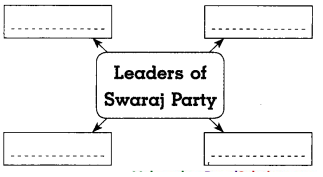
Answer:
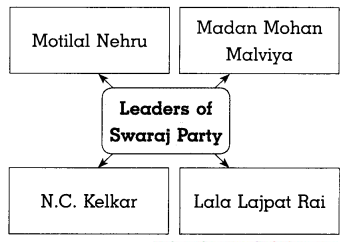
Question 2.
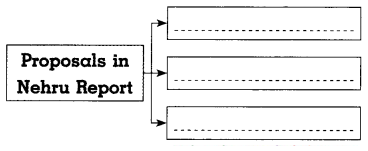
Answer:
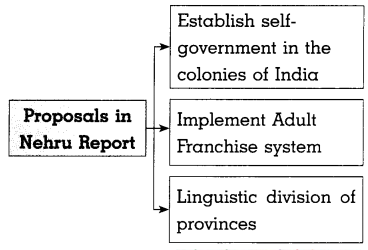
Question 3.
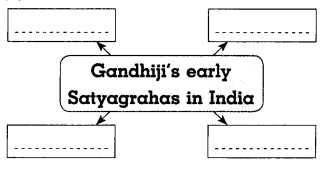
Answer:
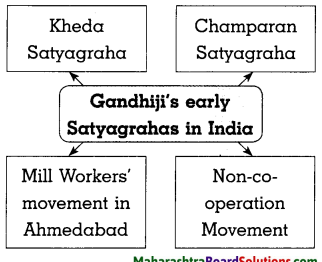
Answer the following questions in one sentence :
Question 1.
Which principles gave a new direction to the freedom movement?
Answer:
The principles of truth and non-violence gave new direction to the freedom movement.

Question 2.
How was the constructive programme beneficial?
Answer:
Due to the constructive programme, the national movement became more comprehensive in rural areas.
Question 3.
How did Lala Lajpat Rai react after he was attacked by the British officer?
Answer:
Lala Lajpat Rai said that Every blow on my body will prove a nail in the coffin of the British Empire, when he was attacked by the British officer.
Write short note :
Question 1.
Gandhiji’s work in South Africa :
Answer:
- In 1893, Gandhiji went to South Africa for some legal work where he began his political work.
- Many Indians had settled in South Africa for the purpose of trade and business.
- They were treated as criminals and humiliating treatment was given to them.
- Many restrictions were imposed on their freedom like it was compulsory for them to carry an identity card.
- Gandhiji adopted the path of Satyagraha and gained justice for them.
Question 2.
Champaran Satyagraha :
Answer:
- The farmers in Champaran region in Bihar were forced to cultivate indigo.
- The cultivators suffered as they received a fixed amount as price from the plantation owners.
- In 1917, Gandhiji went to Champaran and organized the farmers.
- He launched agitation by adopting the technique of Satyagraha.
- The farmers were given justice and thus Gandhiji was successful in his first satyagraha in India.

Question 3.
Work of Swaraj Party :
Answer:
- The leaders of the Swaraj Party put up an idea of contesting elections and obstructing the work of the government.
- They severely opposed unjust policies of the government.
- They demanded that a Responsible Government should be given to India.
- They demanded for Round Table Conference.
- They made a resolution in Assembly which demanded the release of political leaders taken as prisoners.
- Many resolutions were passed in the Central Legislative Assembly but were rejected by the government.
Question 4.
Nehru Report :
Answer:
1. Berkenhead, the Secretary of State of India, criticised that Indian leaders were incapable of drafting a unanimously accepted constitution for India.
2. This challenge was taken up by all party committee under the chairmanship of Pandit Motilal Nehru.
3. The proposals of the Nehru Report were :
- implement Adult Franchise system in India,
- establish self government colonies of India, and
- division of provinces on linguistic division.
Explain the following statements with reasons :
Question 1.
No-tax campaign in Kheda district was successful.
Answer:
- Due to continuous famines the crops had failed in Kheda district of Gujarat.
- But the farmers were forced to pay land tax by the government.
- Gandhiji suggested to the farmers that they should refuse to pay tax.
- The farmers started the campaign to scrap the tax in 1918.
- The tax was suspended by the British Government which made the movement successful.

Question 2.
The movement started by Mill workers at Ahmedabad was successful.
Answer:
- During the First World War the inflation was very high.
- The mill workers demanded for rise in salary which was refused by the mill owners.
- Gandhiji advised the workers to go on hunger strike.
- In the end, the mill owners had to back off and the salary of workers was increased.
Question 3.
The British government passed the Rowlatt Act in 1919.
Answer:
- Indians extended help to the British government in the First World War.
- The Indians expected that after the war is over there will be a system of governance for taking decision for the well-being of the IndiAnswer:
- Moreover, the rising prices, increased taxes led to growing unrest among the Indians.
- To suppress this discontent and suggest measures about it Rowlatt Act was passed in 1919.
Answer the following questions in 25-30 words :
Question 1.
Why was the Hunter Commission appointed?
Answer:
- General Dyer ordered an unrestrained firing on the unarmed people who gathered for a meeting on 13th April 1919, at Jallianwala Baug.
- About 400 people were killed and injured. The injured did not receive any medical help.
- There was nationwide protest against this act.
- Rabindranath Tagore gave up the title of Sir given by the British government.
- The Indians demanded an enquiry against this massacre. So the British government appointed Hunter commission.

Question 2.
Why did Gandhiji support the Khilafat movement?
Answer:
- Indian Muslims started a movement to support Khalifa known as the Khilafat Movement.
- Gandhiji felt that if Hindus and Muslims unitedly start a national movement then the government can be brought to its senses.
- Therefore, Gandhiji supported the Khilafat movement.
- The Khilafat committee accepted Gandhiji’s proposal and extended support to the Non-co-operation movement.
Question 3.
How was Simon Commission opposed in India?
Answer:
- The Indian National Congress boycotted the Simon Commission because there was not a single Indian in it.
- In 1928, when the commission arrived in India, people strongly protested against it shouting ‘Simon go back’.
- The police lathi charged the demonstrators. Lala Lajpat Rai himself led the demonstrators in Lahore.
- He was injured in lathi charge and succumbed to his injuries.
Question 4.
Why was Gandhiji sent to six years of imprisonment?
Answer:
- Gandhiji was arrested in March 1922 for writing three anti-national articles in ‘Young India’.
- His trial was conducted in a special court set up in Ahmedabad.
- The charges were levied against him. He was imprisoned for six years.
Read the passage and answer the questions given below :

Question 1.
What was the pledge taken by Indians on 26th January 1930?
Answer:
On 26th January 1930, people all over the country took the pledge for carrying out of freedom movement with non-violent means for attainment of independence of India.

Question 2.
Why was the demand of Poorna Swaraj passed in Lahore session?
Answer:
1. The objective of Dominion Status was not acceptable to Pandit Nehru, Subash Chandra Bose and other young leaders.
2. Due to their influence, the resolution of demanding complete independence i.e. ‘Poorna Swaraj’ was passed in the Lahore session.
Question 3
Why was the Lahore session historic?
Answer:
- The Indian National Congress gave up the objective of Dominion Status.
- A resolution of complete independence was passed and it became the objective of the national movement.
- A resolution was passed to observe 26th January as the Independence Day.
Answer the following in detail :
Question 1.
Give an account of the Jallianwala Baug Massacre.
Answer:
Points :
(a) Preceding events
(b) Massacre
(c) Reactions
(a) Preceding events :
- The British government resorted to suppressive measures as the protest was more intense in Punjab province.
- Amritsar became the centre of this movement.
- Gandhiji was prohibited from entering the province of Punjab.
- General Dyer had banned public meetings in Amritsar.
- Dr. Satyapal and Dr. Kitchelu were arrested for their involvement in Amritsar Hartal case.
(b) Massacre :
- Despite the ban, a public meeting was held at Jallianwala Baug in Amritsar on 13th April 1919 on the occasion of Baisakhi.
- General Dyer deployed troops around the single gate that led to the ground. .
- Without giving any warning, he ordered unrestrained firing on the unarmed people who had assembled for the meeting.
- 1660 rounds were fired. The firing continued until the ammunition was over.
- About 400 men and women were killed.
- Curfew was announced after the firing which made it impossible for medical help to reach.

(c) Reactions :
- Military law was imposed in entire Punjab. Many were imprisoned.
- This led to discontent among the IndiAnswer:
- Rabindranath Tagore gave away the title of ‘Sir’ given by the British.
- As Indians demanded the enquiry, the British government appointed the Hunter Commission.
Question 2.
Give an account of the Non-co-operation.
Answer:
- According to Gandhiji, the British rule lasted in India only because of the co-operation extended by the IndiAnswer:
- If the Indians withdraw this co-operation and adopt complete non co-operation then the British government will collapse.
- With this intention, Gandhiji devised and executed Non-co-operation Movement.
- The Indian National Congress passed the resolution of Non-co-operation Movement at its Nagpur session in 1920.
- The reins of the movement was given in the hands of Gandhiji.
- According to this resolution there would be : (i) Boycott of government offices and courts, (ii) Boycott of government schools and colleges, (iii) Boycott of foreign goods and clothes.
- Boycott and bonfire of foreign clothes was seen at several places and demonstration in front of shops selling such goods.
- Motilal Nehru, Chittaranjan Das, etc. boycotted court by giving up their practice.
- Schools and colleges imparting national education were started.
- Elections were boycotted.
- The movement spread from the planters in Assam to rail workers in Bengal.

Question 3.
Do you feel that the nation still needs the constructive programme started by Mahatma Gandhi? Why?
Answer:
- Gandhiji implemented the constructive programme along with Non¬co-operation Movement.
- It included Hindu-Muslim unity, prohibition of alcohol, removal of untouchability, etc.
- In spite of completion of 70 years of independence, these problems still exist.
- Communal and religious riots take place. It causes great loss of life and property.
Therefore it is necessary to implement constructive programme in present times.